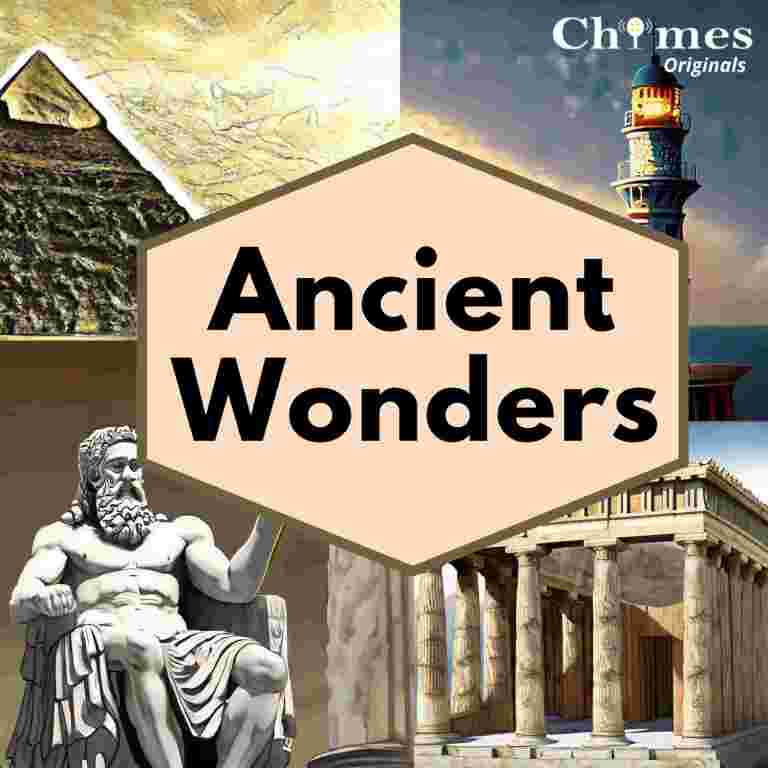About Seven Ancient Wonders Of The World
In the grand tapestry of human history, there exist marvels that transcend the boundaries of time and culture. These are the seven ancient wonders of the world, a collection of extraordinary creations that once stood as testaments to human ingenuity and ambition.
From the mystical and elusive Hanging Gardens of Babylon to the majestic Great Pyramid of Giza, each wonder beckons us to embark on a journey through time, uncovering the secrets and stories of these incredible feats.
As we stand on the precipice of a new era, it is essential to pay homage to these ancient marvels that have fascinated, inspired, and perplexed generations of scholars, explorers, and dreamers. They remind us of our ancestors’ remarkable ability to shape the world around them, often defying the limitations of their times.
So let’s start our journey of seven wonders of the ancient world, to explore these architectural, artistic, and engineering masterpieces.
1. The Great Pyramid of Giza
Built over 4,500 years ago during Pharaoh Khufu’s reign, the Pyramid of Giza stands as the largest and oldest of the Giza Plateau’s pyramids, near the Nile River’s western bank.
Khufu, also known as Cheops, commissioned the pyramid as his eternal resting place, following his ascent to the throne in his twenties. The pyramid’s construction involved impressive engineering, with theories suggesting inclined banks and sledges for moving massive stone blocks. The pyramid houses mysterious inner chambers, including the King’s Chamber and hidden tunnels, though it remains uncertain whether Khufu’s body was ever interred there.
The Great Pyramid’s cultural significance in ancient Egypt extended beyond a burial chamber, symbolizing the pharaoh’s divine status and his journey into the afterlife. It also had a profound economic impact, providing jobs to thousands during its construction.
Throughout history, the pyramid has captivated the world’s imagination, inspiring explorers and researchers to uncover its secrets. Some believe its architecture holds celestial knowledge. Today, the Great Pyramid stands as a symbol of Egypt’s rich heritage and a magnet for tourists worldwide.
Enjoy the full podcast of The Great Pyramid of Giza on Chimes Mobile App or read about The Great Pyramid on Wikipedia
2. Colossus of Rhodes
Rhodes, steeped in mythology as the birthplace of the sun god Helios, found itself under siege by Demetrius I in 305 BCE. Despite a year-long assault, the Rhodians’ resilience prevailed, forcing Demetrius to retreat. In celebration of their victory, they commissioned the renowned stone carver Chares of Lindos to create a colossal bronze statue of Helios.
Standing at an expected height of around 108 feet, the Colossus of Rhodes was a marvel of ancient architecture. Constructed using iron, stone, and bronze, it represented Greece’s artistic and creative prowess. Legends surround its creation, with one story suggesting that it was forged from the melted-down weapons of defeated enemies.
Tragically, the statue met its demise in 226 BCE when an earthquake caused it to collapse into the harbor. Subsequently, Arabian forces destroyed the remaining pieces in 654 CE. The Colossus held immense significance for Rhodes, symbolizing their unity, bravery, and economic prosperity. It attracted visitors and traders from afar, boosting the city’s economy.
Efforts to rebuild the Colossus have been discussed, but the high costs have hindered progress. Nevertheless, its legacy endures, serving as a cultural bridge between different civilizations and inspiring monumental architecture worldwide. The Colossus of Rhodes has left an indelible mark on literature, with references in poems like Sylvia Plath’s “The Colossus” and Emma Lazarus’s “The New Colossus,” which is engraved at the base of the Statue of Liberty.
Though the Colossus no longer stands, its impact on art, architecture, and language persists, reminding us of the enduring power of human imagination and ambition.
Enjoy the full podcast of The Colossus Of Rhodes, one of the Seven Ancient Wonders of The World, on Chimes Mobile App.
3. The Hanging Gardens Of Babylon
Constructed in the 6th century BCE by King Nebuchadnezzar II of the Neo-Babylonian Empire, the Hanging Gardens were a testament to the king’s love for his wife, Queen Amytis, who longed for the lush landscapes of her homeland in Media (present-day Iran). These gardens transformed the arid plains of Babylon into a verdant oasis, with cascading terraces, vibrant plants, fragrant flowers, and intricate sculptures.
Described in ancient texts as a square structure with cascading tiers and a height of approximately 75 feet, the gardens featured a remarkable irrigation system that transported water from the Euphrates River. Stone balconies, covered with materials like reeds, bitumen, and lead, ensured water retention.
The Hanging Gardens held profound cultural, social, and religious significance. They were a symbol of Babylon’s power, ingenuity, and cultural fusion, bringing together artisans and craftsmen from diverse backgrounds. The gardens served as a gathering place for the community, fostering intellectual and spiritual exchange.
Despite their undeniable historical importance, there is an ongoing debate among historians and archaeologists regarding their existence. Some believe the gardens were a creation of imaginative writers, while others contend they were real but may have been located in Nineveh, the capital of Assyria.
While conclusive evidence remains elusive, discoveries by archaeologist Robert Koldewey in the northeastern section of the Babylonian palace, including underground rooms and a well, provide tantalizing clues about the potential existence and location of the Hanging Gardens.
The Hanging Gardens of Babylon, whether a historical reality or a captivating myth, continue to inspire wonder and admiration for the creativity and ingenuity of ancient civilizations. They remind us to appreciate beauty and seek knowledge, even when the mysteries of history remain unsolved.
Enjoy the full podcast of The Hanging Gardens of Babylon, one of the Seven Wonders of The Ancient World, on Chimes Mobile App.
Learn about the Countries of the world in our Little Explorer podcast.
4. The Lighthouse of Alexandria
The Lighthouse of Alexandria was a beacon of light that once illuminated the ancient city’s shores.
Located in the historic city of Alexandria, Egypt, this colossal structure was built around the third century BCE, under the patronage of Ptolemy I and completed during the reign of his son, Ptolemy II Philadelphus. Its primary purpose was to guide ships safely to the bustling harbor, as Alexandria was a thriving hub of trade and commerce.
Designed by the renowned architect Sostratus of Cnidus, the lighthouse stood at an impressive height of approximately 110 meters and consisted of a square base, a cylindrical middle section, and a slender tower. It was adorned with decorative elements, including statues, reliefs, and columns, adding to its grandeur.
The Lighthouse of Alexandria served multifaceted roles. It safeguarded sailors from treacherous waters, boosting maritime trade and the city’s economic prosperity. It also symbolized the power and prestige of the ruling Ptolemaic dynasty and the city itself. Dedicated to the sea god Poseidon, the lighthouse held religious significance, reflecting the maritime importance of Alexandria.
Over time, the lighthouse faced the ravages of earthquakes, culminating in its eventual demise in the 15th century CE when the Mamluk Sultanate dismantled it for repurposing. Today, no significant physical remnants remain above ground, but archaeological efforts continue to uncover fragments and artifacts, preserving its legacy.
Though the Lighthouse of Alexandria no longer graces the shoreline, its impact on maritime safety, culture, and architecture resonates through the ages, reminding us of the enduring legacy of this ancient wonder.
Enjoy the full podcast of The lighthouse of Alexandria, one of the Seven Ancient Wonders of The World on Chimes Mobile App.
5. The Mausoleum at Halicarnassus
Situated in the ancient city of Halicarnassus, present-day Bodrum, Turkey, this magnificent tomb was commissioned in the 4th century BCE as the final resting place for Mausolus, the ruler of Caria. His wife and successor, Artemisia II, continued the construction of the mausoleum as a tribute to her late husband.
Designed by Greek architects Satyros and Pythius, the Mausoleum was an architectural marvel, standing at a height of approximately 45 meters. It featured a rectangular base with a pyramidal superstructure, adorned with intricate sculptures and reliefs depicting a wide range of subjects.
The Mausoleum not only commemorated Mausolus and Artemisia II but also symbolized the cultural fusion of Greek, Egyptian, and Persian influences, showcasing the interconnectedness of different civilizations during that era. Beyond its architectural grandeur, the Mausoleum served as a social and cultural hub for the local community, hosting events, ceremonies, and festivals that fostered a sense of identity and pride among the people of Halicarnassus.
Throughout its long history, the Mausoleum faced various challenges, including conquests and earthquakes, but it stood resilient. Unfortunately, it eventually met its demise as its stones were repurposed for other construction projects during medieval times.
Despite its physical disappearance, the legacy of the Mausoleum at Halicarnassus continues to inspire and influence art, architecture, and cultural appreciation worldwide. Its enduring impact is a testament to the creativity and innovation of humanity throughout history.
Enjoy the full podcast of The Mausoleum at Halicarnassus, one of the Seven Ancient Wonders of The World, on Chimes Mobile App.
6. Statue of Zeus
The Temple of Zeus and its grand statue were constructed between the 5th and 4th centuries BCE. The primary purpose was to showcase devotion to Zeus, who was not only the supreme god but also the patron deity of the Ancient Olympic Games held in Olympia. The temple and statue served as a powerful symbol of Zeus’s importance and the significance of the Games.
The statue itself was an extraordinary creation, standing at approximately 13 meters tall. It depicted Zeus seated on a majestic throne, holding a scepter in one hand and a statue of Nike, the goddess of victory, in the other. The statue was crafted by the renowned Greek sculptor Phidias, who used a combination of wood, ivory, gold plates, and precious stones to create this masterpiece. Its face was said to exude a serene and majestic expression.
The Temple of Zeus, where the statue resided, was a remarkable engineering marvel, featuring impressive Doric columns, intricate friezes with mythological scenes, and a grand entrance known as the Propylaea. Inside the temple, other sculptures and artworks adorned the sacred space, making it a breathtaking display of ancient Greek artistry and religious devotion.
The Statue of Zeus quickly gained fame and became a revered religious symbol. During the Olympic Games, a procession would make its way to the temple, with athletes, priests, and officials paying respect to the god before the festivities began. The statue silently watched over the grandeur of the games and the unity they brought to the Greek city-states.
However, as Christianity rose to prominence in the Roman Empire in the fourth century CE, the pagan temples and statues like the Statue of Zeus began to lose their significance. The Temple of Zeus suffered a devastating fire in 426 CE, leading to the unfortunate destruction of the wooden statue. The remaining ruins of the temple were later destroyed by earthquakes.
Today, the Statue of Zeus may only exist in fragments and historical records, but its legacy lives on. Its beauty continues to inspire awe and wonder, and it serves as a testament to the enduring power of human creativity and the impact of great works of art on society.
Enjoy the full podcast of The Statue of Zeus, one of the Seven Ancient Wonders of The World, on Chimes Mobile App.
7. The Temple of Artemis
Constructed around 550 BCE in the ancient city of Ephesus, located in present-day Selçuk, Turkey, this temple went through cycles of destruction and restoration. It was first built in the Bronze Age, but its most renowned version was commissioned by King Croesus of Lydia, a region in western Anatolia known for its wealth and cultural contributions.
Artemis, the deity to whom the temple was devoted, played a significant role in Greek mythology and religion. She was revered as the goddess of the hunt, wilderness, childbirth, and fertility, symbolizing the natural world’s power and the protection of wild animals. The Temple of Artemis stood as a majestic example of architectural grandeur, boasting 127 towering marble columns, each adorned with intricate carvings and sculptures.
Temple’s roof was covered with terracotta tiles, and its entrance, known as the propylaea, featured a monumental gateway with elaborately crafted columns and arches. Inside the temple’s vast cella, a colossal statue of Artemis, created by the renowned sculptor Phidias, was kept. The temple quickly became renowned, attracting pilgrims, traders, and visitors from across the Mediterranean world.
Tragically, in 356 BCE, temple was destroyed by fire, an act of arson by Herostratus, motivated by a desire for personal fame. Despite this setback, reconstruction efforts began, surpassing the original temple in size and magnificence. Alexander the Great offered to fund the temple’s reconstruction, but the Ephesians refused, suggesting it is inappropriate for one god to build a temple for another.
However, the temple’s fate took another turn during the Roman period, as importance of Ephesus declined, leading to its abandonment and eventual disrepair. Over time, the once-majestic structure was reduced to ruins, serving as a quarry for other construction projects. Today, archaeological excavations and restoration efforts have preserved what remains of the Temple of Artemis.
While the physical structure may have been lost to time, its historical and cultural significance endures and its story reminds us of the impermanence of human achievements and the enduring legacy they leave behind.
Enjoy the full podcast of The Temple of Artemis, one of the Seven Ancient Wonders of The World, on Chimes Mobile App.
FAQ'S about Seven Ancient Wonders of The World
Which is the oldest ancient wonder?
Pyramids of Giza is the oldest of the 7 ancient wonders.
Is Table Mountain also considered as an ancient wonder of the world?
South Africa’s Table Mountain is a natural wonder of the world and not man made. Hence, it is not considered in the official list of the 7 Ancient Wonders.
Why are seven ancient wonders so famous?
The Seven Wonders of the Ancient World are well-known because they depict stories of human ingenuity and technological prowess, as well as how civilizations left their imprints on the world and society.
Who chose the 7 ancient wonders?
These Seven Wonders of the Ancient World were originally chosen by Hellenic travelers passing through Persian, Babylonian, and Egyptian lands.





